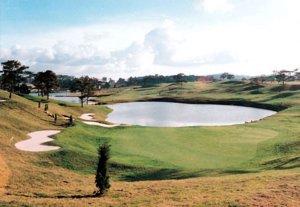Golfing in Vietnam
My wife and I went to Dalat to escape the stupefying heat of the coast. As the road switched relentlessly back and forth I began to wonder if car sickness was a worthwhile trade for heat and humidity.
Cramped in a jammed, straining mini-bus, I scanned the horizon, looking for a straight, flat stretch of pavement that might indicate we were getting close to our alpine destination. What I saw was an endless series of hairpin turns that disappeared into the Central Highlands of Vietnam.
As we continued to climb, the countryside became greener and greener. The oppressive heat of the coast was indeed behind us. The scrub of the hills gave way to open alpine pastures and then cool pine forests. We rounded a few hundred more bends, were shunted onto a still more decrepit and anemic mini-bus, and began climbing again. That was when I saw it.
In what seemed to be the middle of absolutely nowhere stood a large billboard. "Welcome to Pine Lake Golf Club," it advertised, "The First Championship Golf Course in Vietnam." Beneath that impressive caption, a giant golf ball was teed up waiting for the blow of an equally gigantic driver.
"Nina, we've got to go golfing," I said to my wife. Golf was not on her mind. The road and a double dose of Dramamine had drained all the color from her face. "Oh yeah," she said, "we've got to go golfing."
After recovering from the trip to Dalat, I set out for the golf course. Nina wasn't interested. She muttered something about golf being a "foolish game" and returned to the novel she was reading.
Dalat is a quaint tourist village wrapped around a small lake. The town and market are on one side, the university on another. A string of beautiful mansions sit above the lake and look across the water to one of Vietnam's few golf courses.
In a country of greens, the Dalat Pine Lake Golf Club may be the greenest spot of all, punctuated only by the conical straw hats of the 300 employees who groom the course with Asian precision, blade of grass by blade of grass. Overlooking the course I thought that if Eskimos have a hundred words for snow, then the Vietnamese must have a thousand for green.
The day I arrived the course was in the latter throes of a major renovation. The original nine holes built by the French in 1920 had been reconfigured into a full-fledged eighteen-hole championship course. Everywhere workers were grooming the grass, installing irrigation, digging holes for the thousands of Monterey pines that had been imported from the U.S. and were awaiting planting.
Standing near the old clubhouse, all of Dalat was visible. Plush, unmarred fairways meandered past Dalat University and the red star put up over the campus by the Russians. Pure white sand-traps contrasted with the red-roofed cathedrals built by the French. Next to the third hole loomed the slender smokestack and concrete dome of Vietnam's only nuclear facility, built by the U. S. in the 1960s. From the old clubhouse, one can observe the last 300 years of Vietnam's colonial history. The resurrection of the golf course seemed to be a testament to Vietnam's latest sea of change.
The clubhouse was reminiscent of the charm Dalat must have once had. Newly painted, the yellow Tudor building had broad white trim. It was covered with blooming bougainvillea and rimmed with eighty-foot pines. It might have been an angler's club located in the Lake District of England.
"May I help you?" I heard someone ask. A young female caddy approached with the tentativeness of an autograph seeker. As we walked along the course, Huong told me she was a 1992 English graduate from Danang University. She said she wanted to practice her English so that she could become "an excellent caddy." I wanted to help, but Huong always gave the same answer to every question. "I think so," she would say, no matter what I asked.
We were soon joined by another young woman, also a caddy. They seemed to be on the prowl for anyone who might be interested in speaking English or possibly playing golf. As I had for Huong, I answered the second caddy's questions regarding my name, age and place of birth. Then I asked her name. "Huong," she told me.
Huong and Huong accompanied me on my stroll. The course, which bumps right up against Dalat itself, was surprisingly quiet. Except for the rhythmic chik-a, chik-a, chik-a of the irrigation equipment and the occasional growl of distant motorcycles, Dalat Pine Lake was like no other urban place in Vietnam: it was quiet.
Back at the clubhouse the bartender, a young man, was also interested in practicing English. Reading from a primer, he kept repeating a phrase that included the expression "a clear conscience." Over and over again he read this passage. When he brought me a can of Miller Genuine Draft, I asked him if he had "a clear conscience." "I think so," he told me.
I was beginning to suspect that someone had told all the employees at the Dalat Pine Lake to answer "I think so" whenever they were spoken to in English. As I watched the bartender return to his station (and his primer) I noticed the sign above the bar that read "Green, the color of happiness & friendship." I pondered this for a moment, wondering if it referred to the green of the course or the green the course promoters thought would soon be flowing into Dalat from foreign golfers willing to pay the seventy-four dollars charged for green fees, club rental and caddying.
"Would you like to play today?" a young woman asked from behind the counter. "Not too busy," she added as though that would pull me away from my beer and out into the heat of early afternoon.
Never expecting to play golf in Vietnam, I had foolishly left my clubs, balls, shoes and plaid pants at home. But the brand new course was too inviting to pass by. I was quickly outfitted with a shiny new set of Wilson clubs and assigned two new caddies, Vinh and Minh. I purchased three Slazenger balls for ten dollars and headed outside. Vinh, who was hardly as big around as the Wilson "Sam Snead" bag slung over her shoulder, took care of my clubs. Minh trotted alongside with an umbrella.
"Where would you like to begin?" Vinh asked. This seemed like an odd question. Although I am an infrequent golfer I knew that the eighteen holes of a golf course were numbered sequentially and generally one begins at hole number one. Vinh explained that the course was being laid out so that the first hole would be near the new clubhouse which had not yet been constructed. The old clubhouse was nearer to the third hole. She said it would be a convenient place to start and asked if I would like to begin there. "I think so," I told her.
I took a look at the third hole and thought again. It was a short par three that ran along the boundary of the course. Not ready to lose one of my dearly purchased balls on the first hole I suggested we consider another hole. Hole number four was well inside the perimeter of the course. I decided it would be a safer place to start.
Vinh and Minh were very enthusiastic about caddying but seemed to know nothing about the game of golf. Neither had ever played. They offered clubs with a hesitancy that indicated they expected me to correct their selections. There were no players charging up behind us so I thought I could teach them some of the fundamentals of the game in between shots. What began as a chance to play golf in an exotic location quickly became a roving English-as-a-second-language class.
Our first hole, the fourth, was a par four, dog-leg to the left. For the non-golfer, "par" is a difficult term to understand. Par can be three, four, five or occasionally six, depending on the length and difficulty of the hole. Simply getting a "par" is an accomplishment of note for the infrequent golfer. Non-golfers understand the concept through colloquial phrases such as "above par," "par for the course," and "below par." These English idioms, like the PGA tour, have not yet made it to Vietnam. I tried to explain par to Vinh and Minh but we were interrupted by Nham and Thu who explained they wanted to join us -- also to practice their English.
Earlier, the course superintendent, a stocky Australian whose build seemed better designed for rugby than golf, explained that Dalat Pine Lake was the only fully active course in Vietnam. I turned around and realized that I was the only player on the course. As a result there were quite a few caddies with time on their hands. Vinh continued to carry my bag, Minh tried to shade me with her umbrella and Nham and Thu followed along. As I resumed my explanation of par, my four caddies took out small note pads and, with the excitement of cub reporters, began jotting down my every word.
After trying several different definitions my four caddies were still unclear on the concept of par. I decided to let it go and began explaining another golf term, "dog-leg." A dog-leg describes a hole, like the fourth at Dalat Pine, that has a bend in the middle. With hand gestures, I described right dog-legs and left dog-legs. What followed was a rather lengthy discussion among the caddies.
During this, I noticed Vinh gesturing to Minh in the direction of one of the course's refreshment stands. Minh shook her head indicating that it was closed. I realized that my caddies weren't interested in the bend in the fairway but were thinking about one of Vietnam's less appetizing culinary treats, real dog-legs. Once I explained I didn't want to eat, the conversation among the caddies quieted down. I asked if they understood the meaning of dog-leg. In unison they answered, "I think so." I wasn't so sure. I hit a three-wood from the fairway and we continued on, without further talk of food.
The hard laterite soil of Dalat was perfect for a rusty golfer. My line-drive shots rolled forever. I was surprised to find my ball still in play and on the green in just four strokes. I two-putted for a six, thought a moment about explaining "double-bogey," which is two over par, but, given my lack of success with "par," decided to wait until I had achieved a "bogey." We pressed on.
The next hole, number five, was a double dog-leg par four. I wanted to use the hole to reinforce my earlier explanations but realized this would be difficult to do without a flip chart and a pointer.
Unlike the first hole, I hit a beautiful, arching drive that landed dead in the middle of the fairway, in line with the steeple of one of Dalat's colonial period churches. Even my non-golfing caddies recognized the simple, universal grace of a golf ball well struck. They stood back and applauded, softly but with enthusiasm, the way I imagined English ladies would do at a lawn bowling competition.
I negotiated the unusual ninety degree bend just before the green, kept my ball out of the chain of lakes that bisects the course, and two-putted for a bogey five. Before continuing, I explained that on hole number five, par equaled four strokes but that it had taken me five and that was called a bogey. I asked my four caddies if they understood. They thought they did, or so they told me.
The next hole was a long par four that ran straight to the red star above Dalat University. Feeling cocky with the success of the previous hole, I took a mighty swing -- and missed the ball entirely.
I expected twittering, but instead out came notepads and pencils. "Whiff," I explained, "w-h-i-f-f." "Whiff," they repeated among themselves. This onomatopoetic term they seemed to understand immediately.
Figuring that the reputation of American golf was at stake, I steadied myself, took a few practice swings and three deep breaths. When at last I was ready, I drew the metal club head back and swung through the ball effortlessly.
The Slazenger shot off the tee, sure to go 230, perhaps 250 yards. Then it begin to veer to the right, more and more, such that I thought it might return like a boomerang. Here was an opportunity to teach the caddies the terms "hook" and "slice," which are used to describe shots that veer to the left or to the right. I asked them what they called it when a ball did what mine had done. Again, they discussed among themselves. At last they looked at me. Minh sheepishly offered an answer. "Stop?" she said.
From far in the rough, I hit a three wood into a bunker. "Don't worry," Vinh told me. But my game was rapidly falling apart. When we arrived at the trap, Minh asked if I wanted the "bitching wedge." Only three holes into the round and it seemed there was nothing more I could tell her that would improve her English. I took the club she offered and "bitched" out of the trap. I escaped with a triple bogey seven. Nham and Thu were called back to the clubhouse. They left more rapidly than they arrived, perhaps realizing they had nothing more to learn about golf or English from me.
The seventh hole was a straight par three without any obvious hazards. I asked Minh and Vinh if anyone had yet hit a "hole-in-one" on the course. They didn't know the term. I explained it to them but they seemed unimpressed with the difficulty of the trick. I told them that my intention was to be the first to hit a hole-in-one at Pine Lake, assuming that later they would come to understand they had been present at a momentous occasion.
Like Babe Ruth, I pointed to the distant horizon, indicating where I intended to hit the ball. I teed it up, swung a potent three wood and was amazed when the ball soared dead at the pin. Thinking the ball might actually go in, Minh and Vinh applauded vigorously. But the ball fell twenty yards short and again I wound up with a bogey.
The eighth and ninth holes were particularly hazardous. The right edge was bordered by a road and the left side sloped down to a series of water traps. My goal was to survive with all three balls. As I teed up, our threesome was augmented by Miss Oahn and Phan, the first male caddy I had seen. Phan was an adept conversationalist -- in Vietnamese. Soon the party was talking all the time. I explained to him that it was crucial not to speak while a golfer was addressing the ball. "Yes," he said and went on talking.
My tee shot on number eight was a vicious hook that miraculously stopped just at the water's edge. As I stepped around the soggy grass and mud trying to figure out how to hit the ball at all, I realized I had the chance to explain a critical golf term: cheating. I carefully explained how moving the ball from where it had landed would be "cheating" and I would be a "cheater." This, I explained, was not a good thing.
I never quite figured out where my explanation went wrong, but for the rest of the afternoon, the group kept repeating "cheater" and "cheating." I told them to forget about "cheating" as their repeated use would be offensive to some golfers. But unlike par or bogey, they took to "cheating" and continued to repeat it all afternoon as though it were a pronunciation exercise. To get them to forget cheating, I tried to explain the "birdie," which signifies one stroke less than par on a hole. Birdie was so far removed from the experience at hand that my four caddies ignored it entirely and just kept repeating "cheating."
Having passed the water gauntlets of holes number eight and number nine with all three balls in hand, I began the back nine with renewed confidence. The tenth hole also ran along the edge of the club grounds. As I drew my driver back, Phan told a joke of some sort and my audience of four broke up laughing. My ball disappeared down the left side of the fairway with no one having seen it.
I explained to the caddies that a key part of their job was to keep "an eye on the ball." I tried to make this clear by pointing first to my eye and then to the ball. They said they understood. I tried to make it even clearer by explaining that in golf there was a direct relationship between the number of balls lost by the player and the tips garnered by the caddy. I thought this was a handy thing to mention because my next shot went sailing over the out of bounds fence towards a small shop that seemed to produce cement balcony railings. Of course, the caddies had been chit-chatting and no one had even seen the ball.
We searched in the high rough along the fence but found nothing. With no one else on the course and with balls going for three dollars, I was quite determined to search all day. Meanwhile, the fellows in the cement shop, who a minute before had been watching me approach with great interest, were now all very involved with some pantomime of production.
I suggested to Phan that he go ask them if they had seen the ball. He climbed over the fence and began a long conversation. Laughter trickled back to us and soon Phan returned empty handed. I asked Miss Oahn to go ask them if they had seen a ball. She was gone somewhat longer than Phan and, to my surprise, returned with my ball which had indeed bounced right into the shop. "They always steal ball," Miss Oahn told me as I lined up my shot for the green.
I made it to the green in six and was left with a long putt from the fringe. Miss Oahn asked if I wanted the "mutter." I decided it couldn't be less effective than the "bitching" wedge had been and told her yes. After I two putted for an eight, I explained that it was a "putter" and a "pitching wedge." I did my best to explain that the Vietnamese variant of pitching wedge was likely to be offensive to some golfers and could result in diminished tips. This did not, however, lead to improved diction.
By this time it was getting late. Playing by myself, I might have completed eighteen holes. But after looking for balls, explaining the nuances of the sport, and describing why my wife thought golf was a foolish game, dusk was upon us.
We skipped to the eighteenth hole, a par four that led to a mound of dirt I was told would be the new clubhouse. It seemed all 300 employees were at work on the eighteenth fairway, cutting, watering and fertilizing. The course superintendent had explained to me that the workers had all been carefully trained in the proper application of fertilizer. I figured that after all the pesticides and herbicides used on Vietnam, a few extra tons of fertilizer probably couldn't hurt.
As I mounted the tee, the workers put down their tools and moved to the sides of the fairway. The overhead irrigation that had been spraying back and forth was turned off. All eyes were on me.
f ever there was a time I was certain to whiff, duff, or top the ball, this was it. To my surprise, I hit a stunning drive straight down the fairway. As I walked down to my ball, the employees applauded. I found myself involuntarily acknowledging them by touching my index finger to the brim of my hat. It was the closest I'm sure I will ever feel to having been on the professional tour.
The workers continued to watch as I addressed my second shot.
In front of me, the hole sloped down gradually to a large water hazard. The green was just on the other side, nestled in an amphitheater newly planted with trees. I adjusted my hat. I stood back from the ball. I asked Minh for the three wood and then hit a booming shot that cleared the water and bounced onto the green. The workers burst out with a hurrah. Apparently they knew as well as I did how unlikely it was that I would make the shot. As I marched up to the green, the irrigation system squirted back on. The workers squatted back down to resume culling out the bad grass. My moment of glory had passed.
After three hours on the course, Vinh and I were conversing easily. As we made our way back to the first hole, I asked if she was married. No, she told me, she was still single. I asked her why. With great calculation she looked at me and then responded a` la Garbo. "I like to be alone," she said.
Perhaps I should have left well enough alone. The sun was already going down behind the "Valley of Love," a nearby tourist attraction. But I decided to play on. Holes one and two would take me back to the old clubhouse. The caddies checked their watches. Even at fifty dollars a month and two dollars a round, they still had other things to do. A bogey five on the first hole inspired me to continue. But on the second hole my play resembled the road to Dalat, zigging and zagging from one side to the other. I was lucky to come away with a nine. At that point Miss Oahn explained it was time for her to go.
I was now back at the old clubhouse. I could have stopped. I should have stopped. But the third hole was a straightforward, 170 yard par three, a chance to redeem myself. I hit a six iron off the tee and watched my ball head straight out of bounds and directly at Miss Oahn who was on the road bicycling home. My ball zoomed past her and flew deep into the university grounds. Miss Oahn chased the ball down and pedaled it back to me.
My next shot landed in a bunker. I "bitched" back into the university. This time Vinh retrieved the ball and watched me hit into another bunker. Eventually I three-putted for a "septuple" bogey. I didn't try to explain that to Minh and Vinh.
Having begun at the fourth hole and finished at the third, it was time to call it a round. I shot a seventy-seven, just five over par. One of my best rounds ever. That I played only twelve holes was immaterial. I hit a number of beautiful shots, enjoyed a championship course all to myself, spent four hours with a number of charming Vietnamese and still had all three balls. As Vinh walked back to the clubhouse with me, I had one last question to ask her.
"So," I said, "What do you think? Do you think golf is a foolish game?"
She looked around. All her compatriots were gone. She faced my question alone. I wondered if she had learned anything from me about English or golf. At last she answered. "Yes, I think so," she said. Then she looked up at me and smiled. "Do you want to play again tomorrow?" she asked.
I didn't get back to Dalat Pine Lake Golf Club the next day. But someday I will. I still have six holes left to play.
Getting There. Dalat is located at 1,475 meters in the central highlands and can be reached by plane, bus or car. Trains do not stop here. There are regular flights from Saigon to Dalat's Lien Khang Airport. If you want to see the countryside up close, the drive from Saigon to Dalat is about 308 kilometers. Buses (express and otherwise) connect Dalat with Hanoi, Saigon and points in-between. The Dalat bus station is located by the gas station near the central market and the ticket office is open daily from 4:30 A.M. to 5:30 P.M.
 ThingsAsian
ThingsAsian


















